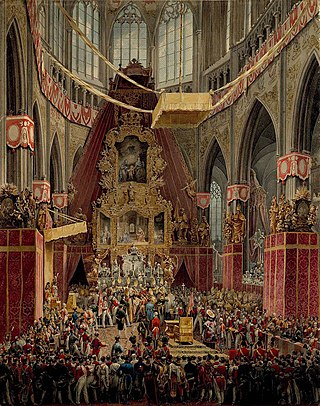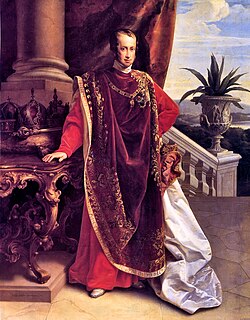Top Qs
Timeline
Chat
Perspective
Ferdinand I of Austria
Emperor of Austria from 1835 to 1848 From Wikipedia, the free encyclopedia
Remove ads
Ferdinand I (German: Ferdinand I. 19 April 1793 – 29 June 1875) was Emperor of Austria from March 1835 until his abdication in December 1848. He was also King of Hungary, Croatia and Bohemia (as Ferdinand V), King of Lombardy–Venetia and holder of other lesser titles (see grand title of the Emperor of Austria). Due to his passive but well-intentioned character, he gained the sobriquet The Benign (German: Der Gütige) or The Benevolent (Czech: Ferdinand Dobrotivý, Polish: Ferdynand Dobrotliwy).[2]
Ferdinand succeeded his father Francis I upon his death on 2 March 1835. He was incapable of ruling the empire because of severe epilepsy, so his father, before he died, made a will promulgating that Ferdinand should consult his uncle Archduke Louis on all aspects of internal policy and urged him to be influenced by Prince Metternich, Austria's Foreign Minister.[3]
Following the Revolutions of 1848, Ferdinand abdicated on 2 December 1848. He was succeeded by his nephew, Franz Joseph. Following his abdication, he lived in Hradčany Palace, Prague, until his death in 1875.[4]
Ferdinand married Maria Anna of Savoy, the sixth child of Victor Emmanuel I of Sardinia. They had no children.
Remove ads
Biography
Summarize
Perspective
Early life
Ferdinand was the eldest son of Francis II, Holy Roman Emperor and Maria Theresa of Naples and Sicily. Possibly as a result of his parents' genetic closeness (they were double first cousins), Ferdinand had hydrocephalus, neurological problems including epilepsy, and a speech impediment. He was educated by Baron Josef Kalasanz von Erberg, and his wife Countess Josephine von Attems.[5]
Reign


Ferdinand suffered from epilepsy. Although he has been depicted as feeble-minded and incapable of ruling, he kept a coherent and legible diary and has even been said to have had a sharp wit. However, suffering as many as twenty seizures per day severely restricted his ability to rule with any effectiveness. Though he was not declared incapacitated, a Regent's Council (Archduke Louis, Count Kolowrat, and Prince Metternich) steered the government.

When Ferdinand married Princess Maria Anna of Savoy, the court physician considered it unlikely that he would be able to consummate the marriage.[6] When he tried to consummate the marriage, he had five seizures. He is also remembered for his command to his cook: when told he could not have apricot dumplings (Marillenknödel) because apricots were out of season, he said "I am the Emperor, and I want dumplings!" (German: Ich bin der Kaiser und ich will Knödel!).[7][8]
1848 Revolution

As the revolutionaries of 1848 were marching on the palace, he is supposed to have asked Metternich for an explanation. When Metternich answered that they were starting a revolution, Ferdinand is supposed to have said "But are they allowed to do that?" (Viennese German: Ja, dürfen's denn des?) He was convinced by Prince Felix of Schwarzenberg to abdicate in favour of his nephew, Franz Joseph (the next in line was Ferdinand's younger brother Franz Karl, but he was persuaded by his wife Sophie to renounce his succession rights in favour of his son) who would occupy the Austrian throne for the next 68 years.
Ferdinand recorded the events in his diary:
The affair ended with the new Emperor kneeling before his old Emperor and Lord, that is to say, me, and asking for a blessing, which I gave him, laying both hands on his head and making the sign of the Holy Cross ... then I embraced him and kissed our new master, and then we went to our room. Afterwards I and my dear wife heard Holy Mass ... After that I and my dear wife packed our bags.
In retirement (1848–1875)


Ferdinand was the last King of Bohemia to be crowned as such. Due to his sympathy with Bohemia (where he spent the rest of his life in Prague Castle) he was given the Czech nickname "Ferdinand V, the Good" (Ferdinand Dobrotivý). In Austria, Ferdinand was similarly nicknamed "Ferdinand der Gütige" (Ferdinand the Benign), but also ridiculed as "Gütinand der Fertige" (Goodinand the Finished).
Ferdinand was also the last ruler to be crowned with the Iron Crown of Lombardy in his capacity as King of Lombardy-Venetia.
He is interred in tomb number 62 in the Imperial Crypt in Vienna.
Remove ads
Honours
 Austrian Empire:[9]
Austrian Empire:[9]
- France:
 French Empire: Grand Eagle of the Legion of Honour
French Empire: Grand Eagle of the Legion of Honour Kingdom of France: Knight of the Holy Spirit, 1816[12]
Kingdom of France: Knight of the Holy Spirit, 1816[12]
 Kingdom of Bavaria: Knight of St. Hubert, 1824[13]
Kingdom of Bavaria: Knight of St. Hubert, 1824[13] Duchy of Parma: Senator Grand Cross of the Constantinian Order of St. George, with Collar, 1826[14]
Duchy of Parma: Senator Grand Cross of the Constantinian Order of St. George, with Collar, 1826[14] Grand Duchy of Hesse: Grand Cross of the Ludwig Order, 11 April 1830[15]
Grand Duchy of Hesse: Grand Cross of the Ludwig Order, 11 April 1830[15] Electorate of Hesse: Grand Cross of the Golden Lion, 26 December 1830[16]
Electorate of Hesse: Grand Cross of the Golden Lion, 26 December 1830[16] Baden:[17]
Baden:[17]
 Kingdom of Saxony: Knight of the Rue Crown, 1830[18]
Kingdom of Saxony: Knight of the Rue Crown, 1830[18] Two Sicilies:
Two Sicilies:
 Württemberg: Knight of the Golden Eagle, 1830[20]
Württemberg: Knight of the Golden Eagle, 1830[20] Kingdom of Sardinia: Knight of the Annunciation, 12 January 1831[21]
Kingdom of Sardinia: Knight of the Annunciation, 12 January 1831[21] Kingdom of Prussia: Knight of the Black Eagle, 24 January 1831[22]
Kingdom of Prussia: Knight of the Black Eagle, 24 January 1831[22] Denmark: Knight of the Elephant, 1 February 1831[23]
Denmark: Knight of the Elephant, 1 February 1831[23] Empire of Brazil: Grand Cross of the Southern Cross[23]
Empire of Brazil: Grand Cross of the Southern Cross[23] Kingdom of Portugal:
Kingdom of Portugal:
 Russian Empire: Knight of St. Andrew, 28 February 1835
Russian Empire: Knight of St. Andrew, 28 February 1835 Saxe-Weimar-Eisenach: Grand Cross of the White Falcon, 2 April 1835[25]
Saxe-Weimar-Eisenach: Grand Cross of the White Falcon, 2 April 1835[25] Sweden-Norway: Knight of the Seraphim, 14 April 1835[26]
Sweden-Norway: Knight of the Seraphim, 14 April 1835[26]

 Ernestine duchies: Grand Cross of the Saxe-Ernestine House Order, May 1835[27]
Ernestine duchies: Grand Cross of the Saxe-Ernestine House Order, May 1835[27] Ascanian duchies: Grand Cross of Albert the Bear, 18 March 1837[28]
Ascanian duchies: Grand Cross of Albert the Bear, 18 March 1837[28] Kingdom of Hanover:[29]
Kingdom of Hanover:[29]
 Spain: Grand Cross of the Order of Charles III, 23 April 1849[30]
Spain: Grand Cross of the Order of Charles III, 23 April 1849[30] Grand Duchy of Tuscany: Grand Cross of St. Joseph[31]
Grand Duchy of Tuscany: Grand Cross of St. Joseph[31]
Remove ads
Ancestry
Summarize
Perspective

Ferdinand's parents were double first cousins as they shared all four grandparents (Francis' paternal grandparents were his wife's maternal grandparents and vice versa). Therefore, Ferdinand only had four great-grandparents, being descended from each of them twice. Further back in his ancestry there is more pedigree collapse due to the close intermarriage between the Houses of Austria and Spain and other Catholic monarchies.
See also
- Charles II of Spain (1661–1700)
- List of heirs to the Austrian throne
- Rulers of Germany family tree. He was related to every other ruler of Germany.
References
External links
Wikiwand - on
Seamless Wikipedia browsing. On steroids.
Remove ads

